Meet Report: 26 May – 2 June 2018.
Nine members and guests assembled in the coastal town of Cahersiveen on the Iveragh Peninsula, about half an hour’s drive southwest of Killarney, arriving in Ireland by ferry and plane in glorious sunshine. We made ourselves comfortable in the Old Monastery, a large Victorian country house built in 1842, which the Club had rented for the week and headed into the town for an evening meal and a Guinness or two.
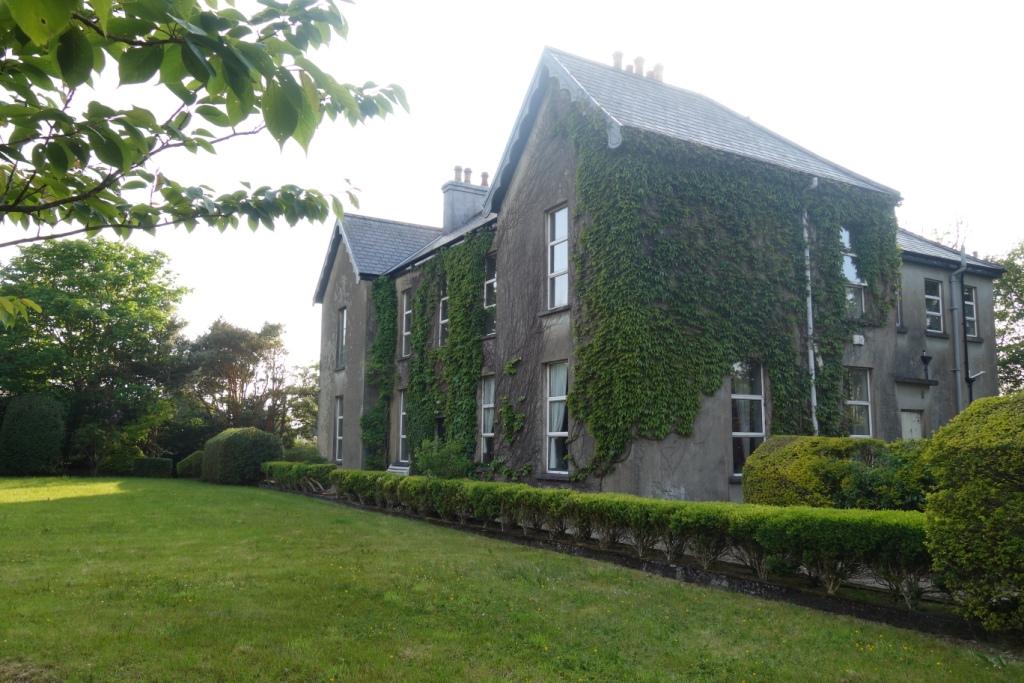
Cahersiveen proved to be a good choice for a base as it was a pleasant laid-back town with several pubs and good restaurants, a butcher, a baker and several food stores and much less busy than Killarney. There were local hill and coastal walks available, as well as the higher peaks of the MacGillycuddy’s Reeks not far away, and plenty of interesting sightseeing to do.
Walking
On Sunday, Mick and Tim made a start on the hills with a circuit of Mangerton Mountain (843m) and Stoompa on a rather misty and damp day. The insectivorous butterworts lining the stream on the initial ascent were the largest either of us had ever seen – more like the size of dog violets.
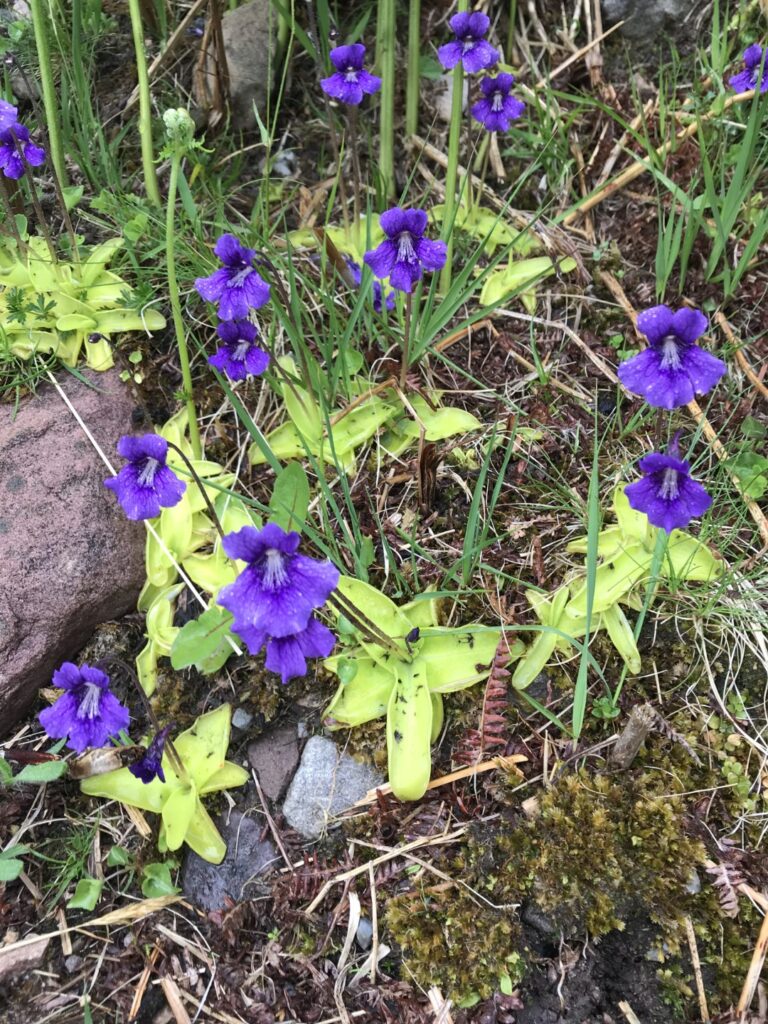
On our descent, Tim found that his new hip was fortunately resistant to dislocation when he inadvertently put his leg down a hole underneath the heather and cracked a rib with his knee instead. Hilary, John and Ros walked up Beentee behind Cahersiveen to enjoy the fine views over the town and Valentia Island. Martyn and Lizzie undertook a circular walk on Valentia Island walking from the car park at the Skelligs Visitor Centre to Clynacatan to Coarha Beg, past St Brendon’s Well to Beenakryraka Head and around to the Tower at Bray Head and back via Clynacatan.
Tim was dropped off by Mick in Kells on Monday to ascend Knocknandobar (690m) to make a 17km traverse back to Cahersiveen. He enjoyed a spiritually uplifting descent, if that is possible, via the 14 stations of the cross. John and Ros took an afternoon walk around Rosebehy Point, that took them way out along Rossbeigh Strand into the bay, a fascinating place where a close eye on the tide was required.
Mick was fit from ten days in Scotland prior to the meet climbing Munros with Bob Peckham, so a fine weather forecast on Tuesday tempted him to do a solo traverse of the MacGillycuddy’s Reeks starting near Kate Kearney’s Cottage at the foot of the Gap of Dunloe, where John kindly provided a lift to the start. The route led up Cruach Mhor (932m) and along a precipitous ridge to The Big Gun (939m) and on to Knocknapeasta (988m), the highest peak in the eastern Reeks. Maolan Bui (973m), Cnoc an Chuillin (958m) and Cnoc Toinne soon followed.
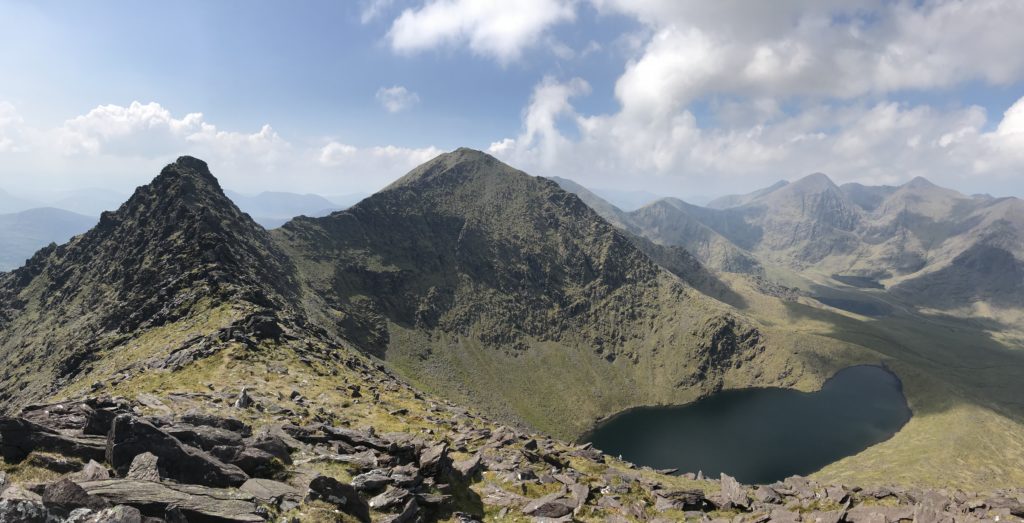
As Mick ascended to the large summit cross on Carrauntoohil (1039m), Ireland’s highest point, he met Tim, John, Lizzie and Martyn on their descent, returning by their ascent route of the Devil’s Staircase from Cronin’s Yard.
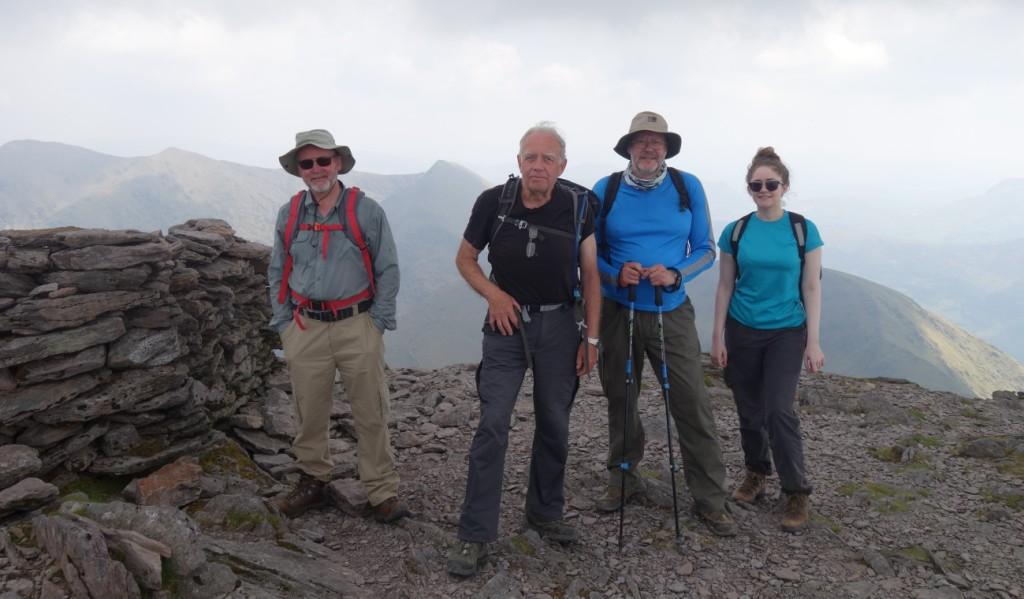
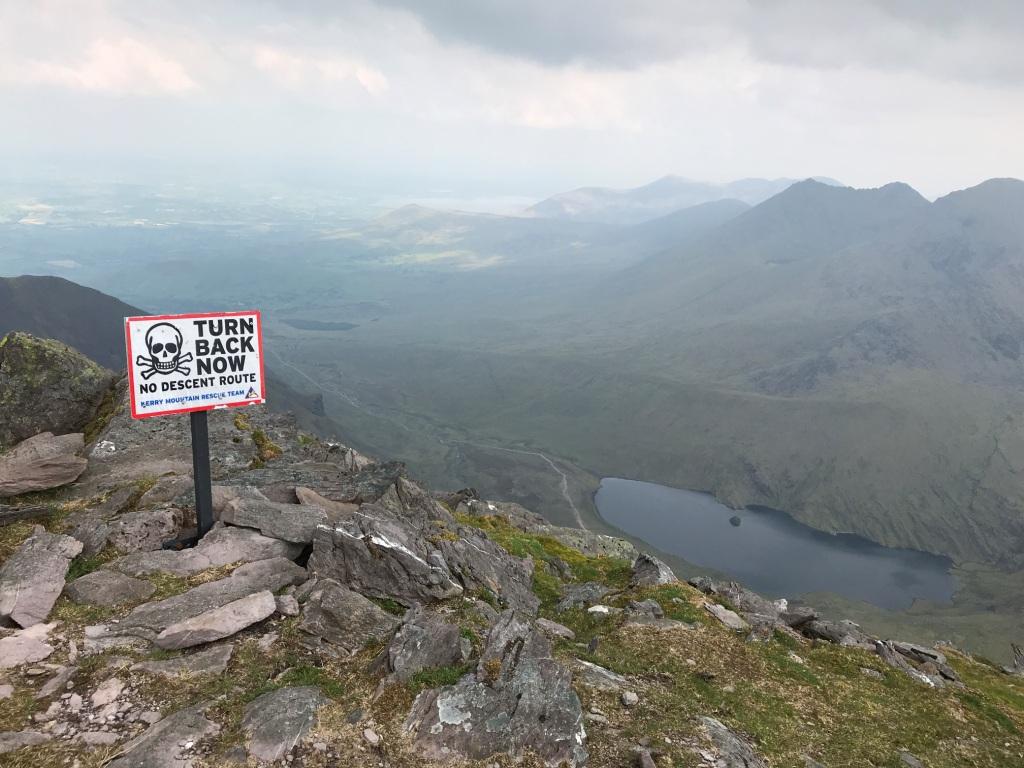
Mick then completed his route over Caher (1001m) and made the long descent to Glencar, where John picked him up, more than slightly tired after 24km and 1868m of ascent.
On Wednesday, Mick and Tim enjoyed an easier day. They walked from Cahersiveen over the summit of Beentee by an 11km circuit known locally as the Carhan Letter loop, with fine views from the top.
Thursday saw Tim in the Glenbeigh hills, Meenteog, Coomacarra (772m), Teermoyle, Mullaghnarakill, Been Hill, Beenmore and Drung. All were done in mist and heavy showers. The descent to the coast road was enlivened by an uncontrolled descent down a 30ft shale embankment to the amusement of some passing tourists. 18km. Meanwhile, Mick and Hilary almost missed the showers and did a coastal walk around Ducalla Head and Bolus carpeted in pink thrift, but the sea mist prevented any views of the sharp Skellig islands.
On Friday Mick and Tim did a walk over Slievagh to Canglass Point to view the sea cave which had penetrated the headland to form a massive collapsed blowhole which put Hull Pot to shame.
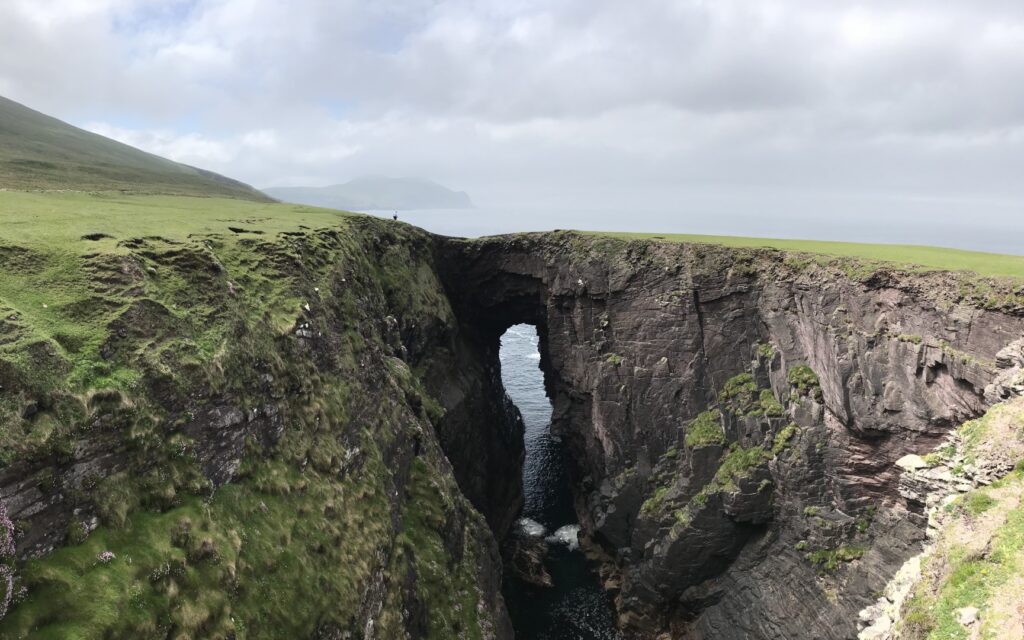
Other activities
Peter and Ann did a lot less walking than they had planned because they brought their dog which on reflection was a mistake. Dogs are not just not welcome in Ireland, they are banned from all open land, even on a lead, and can be shot! Nevertheless, they had a very enjoyable and interesting time being tourists.
Hilary brought her kayak out to Kerry and had a play out in the bay at Coonanna which was surrounded by convoluted black cliffs and was very attractive. It also resulted in a chance encounter with Gerry, a local paddler, who the day after took her out on a cross-estuary trip from White Strand to the island of Beginish via Church Island. This has a basic stone structure, now largely restored, which is a very early church. This had to be seen from the water however, since the tide was running too fast to make a safe landing on the small, steep, rocky islet. Local knowledge of the tides and currents was invaluable and Gerry was an interesting guide to the area generally, not just to its maritime vagaries!
Several parties visited the Kells Bay Gardens containing a large collection of sub-tropical plants which take advantage of the Gulf stream climate.
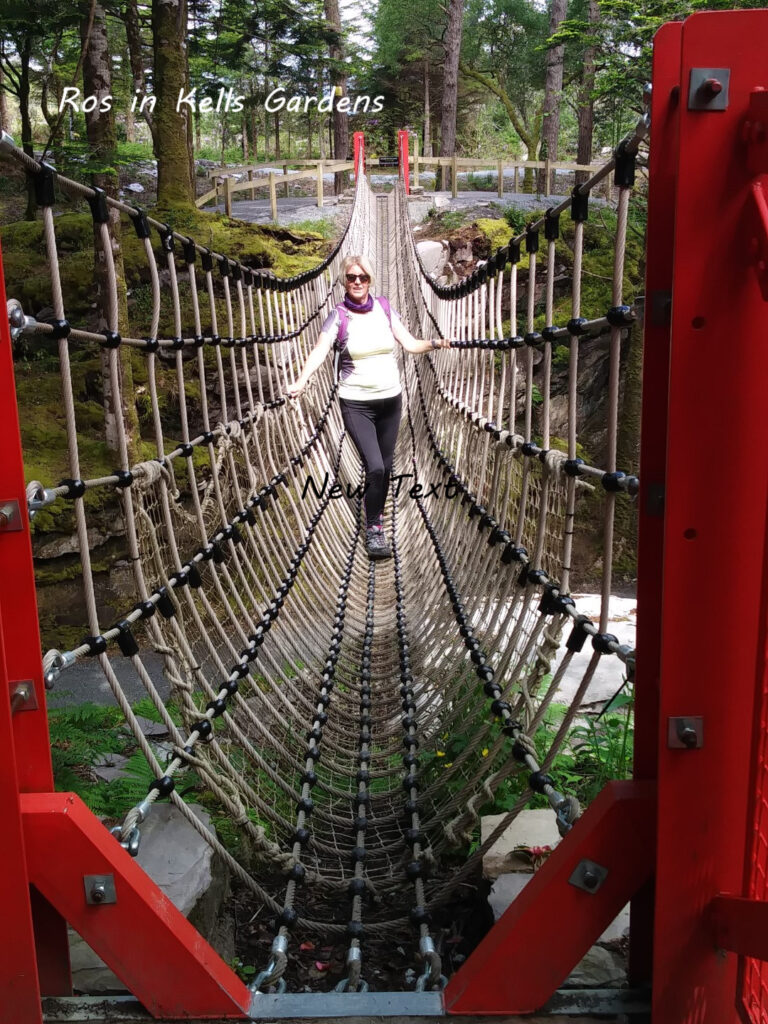
Its most interesting feature was the planted forest of tree ferns, positively prehistoric. Others visited the houses and gardens at Muckross, Derrynane and Glanleam. The latter was a fascinating place, completely run down, with an air of dereliction, but did have a hint of the fairies. The mulberry forest was very distinctive.
Martyn and Lizzie took a trip to Bandon in County Cork to discover some ancestral history on Lizzie’s maternal side. Including a visit to the West Cork Heritage Centre which provided a great insight into the region’s and Ireland’s past .
Various parties during the week visited the imposing Cahersiveen barracks constructed in the Schloss style between years 1870 – 1875 as a police station for the Royal Irish Constabulary to protect the Irish end of the new transatlantic telegraph cable which entered the sea at Valentia Island. Today the building holds an excellent Heritage Centre, dedicated to the life of the 19th century Irish political leader Daniel O’Connell. Born nearby, he became an MP in Westminster and sought separation from Great Britain although he believed strongly in non-violent protest and was very popular with the masses.
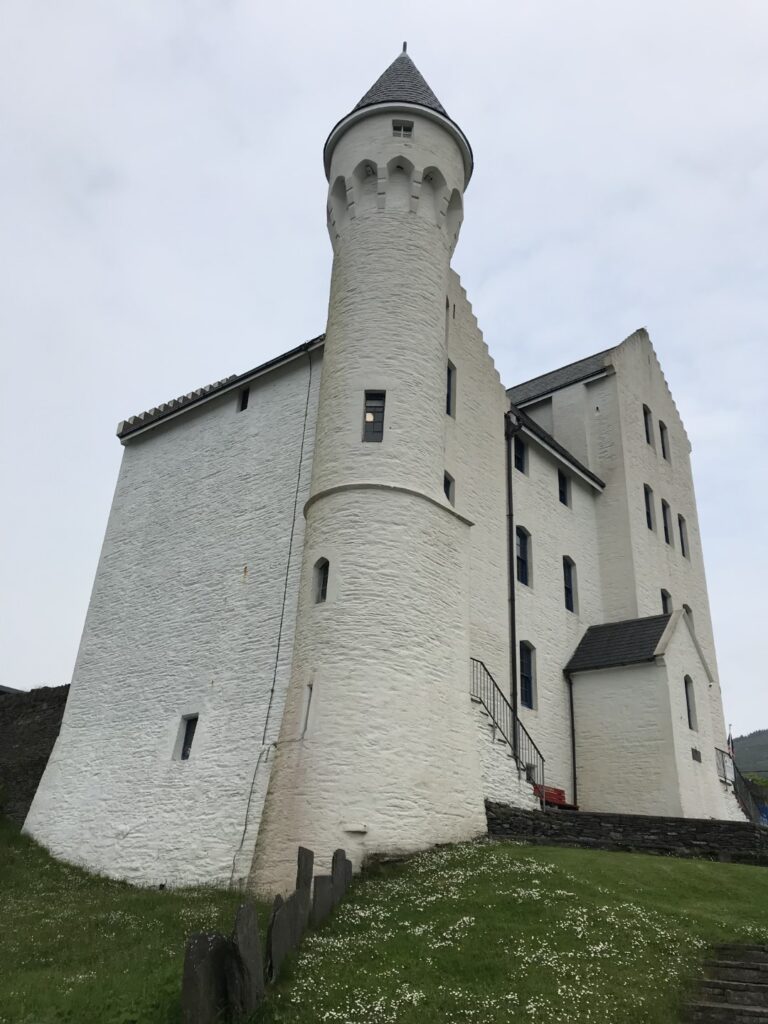
After looking at the ruins of Ballycarbery Castle and going to see the two ancient stone ringforts nearby, most crossed over on the ferry over to Valentia Island and visited several places of interest there, including Geokaun Mountain and the tetrapod footprints.
John and Ros travelled to the centre of the Iveragh peninsular to visit Likeen Wood. This was a good example of a wet woodland of willow and alder growing close to a beautiful river that had been developed as a game fishing venue. They also spent the following couple of days in a busy Dublin during the Irish bank holiday. The Guinness was good though! They spent time walking in Phoenix Park, the largest city park in Europe and the botanical gardens.
As well as the Guinness, we discovered Powers whiskey, as well as enjoying some excellent sea food at Reenard Point. With mostly benign weather, all in all, it was another excellent Irish meet.
MB
Participants
Mick Borroff (President) – Leader, John Brown, Ros Brown, Ann Chadwick, (G), Peter Chadwick, Tim Josephy, Hilary Tearle (G), Lizzie Trasler (G) Martyn Trasler.
Bird List
| Robin, Hooded crow, Swallow, Jackdaw, Grey wagtail | Chaffinch, Pied wagtail, Chough, Wheatear, Blackbird | Skylark, Willow warbler, Cuckoo, Heron, Tree creeper | Meadow pipit, Kestrel, Rock pipit, Stone chat, Swift |
| Gannet, Wren, Sparrow, Rook | Little egret, Cormorant, Gold finch, Black cap | Herring gull, Bullfinch, Starling | Collared dove, Gt. Black backed gull, Raven |
Further Reading
- Hill Walkers Kerry – David Herman (Shanksmare Publications)
- Hill Walkers Atlantic Ireland – David Herman (Shanksmare Publications)
- The Mountains of Ireland: A Guide to Walking the Summits – Paddy Dillon (Cicerone)
- Carrauntooil & MacGillicuddy’s Reeks, A Walking Guide to Ireland’s Highest Mountains – Jim Ryan (Collins Press)
- Killarney to Valentia Island – the Inveragh Peninsula – Adrian Hendroff (Collins Press)
- The Dingle, Inveragh & Beara Peninsulas – Adrian Hendroff (Collins Press)
Leave a Reply